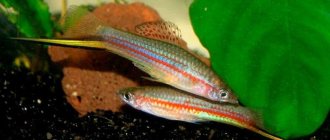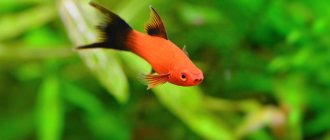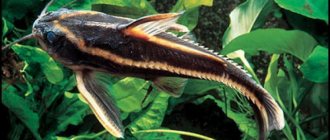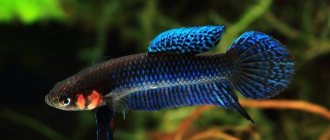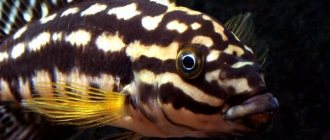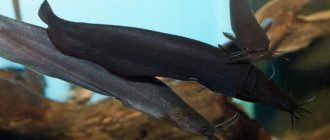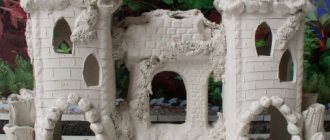The water burro (Asellus aquaticus) is a freshwater crustacean that resembles a woodlice in appearance. The water burro inhabits stagnant or low-flowing inland bodies of water. Active at night. Reproduction occurs from May to August. The water burro feeds on decaying plant parts, algae and bacteria. Serves as food for fish and predatory invertebrates. Body length from 8 to 20 mm.
Structure
The body is flattened dorsoventrally (from top to bottom), oval in shape. Carapace is missing. The head is fused with one anterior thoracic segment. On the head there are 2 sessile compound eyes and two pairs of antennae. The antennae of the first pair are relatively short (1/3 of the body length), the antennae of the second pair are almost as long as the body. The strong mandibles are asymmetrical; one of them (the left one) has a movable plate. The so-called predatory process of the mandibles is used for biting off food, and the ribbed chewing surface is used for grinding it.
For breathing, it uses lamellar gills located in the abdominal region. There are two pairs of maxillae; the first thoracic segment, fused with the head, bears the mandibles. There are seven pairs of thoracic legs (thoracopods) - the first three are directed forward, the next - to the sides, and the remaining three - backward. On the front four pairs of thoracic legs, female water donkeys have leaf-shaped appendages - oostegites, forming a brood chamber (marsupium). The abdominal legs (pleopods) of the first two pairs are arranged differently in males and females. The legs of the first pair in females are greatly reduced, the second pair are completely reduced. In males, both of these pairs are highly modified and play the role of the copulatory apparatus. The outer branch (exopodite) of the third pair of abdominal legs is transformed into an operculum that covers the gill plates - the inner branch (endopodite) of the third pair and legs 4-5 pairs. The hind abdominal limbs (6th pair) are uropods, they have rod-shaped branches and perform a sensitive function. All abdominal segments, except the two anterior ones, are fused with the telson into a common section - the pleotelson.
The ranatra bug (Ranatra sp.) grabbed a water donkey
Description and characteristics of crustaceans
Water donkeys belong to a large population of crustaceans. In Latin their name sounds like asellus aquaticus. This species of isopods is so named because its representatives have thoracic legs of the same size and shape.
Outwardly, these arthropods resemble a cross between a cockroach and a woodlice; it is not for nothing that they are also called water or sea woodlice. The donkey's body is flat, consisting of a head and eight segments covered with a thin layer of chitin. There are two pairs of antennae on the head : some are short and others are long.
Water burros resemble a cross between a cockroach and a woodlice and are also called water or sea woodlice.
This crustacean has seven pairs of long legs: three pairs are directed forward, three are directed backward, and one pair is directed to the side. Near the head there is a pair of grasping false claws.
The thin walking legs of a water donkey have the ability to regenerate if they break or are chewed off by enemies. The newly grown limbs are lighter in color and smaller in size. The average body length of a donkey is about 1.5 cm . The color of crustaceans can be very diverse - from gray-blue to brown. In nature, you can also find completely white individuals.
The crustacean breathes through gills, which are located in the abdominal region. The rear pairs of legs have transformed into gill plates.
Each leg consists of two blades: the upper one serves for the exchange of gases, the lower one serves as a protective cap.
Habitat
The water burro inhabits stagnant or low-flowing inland bodies of water. Hides in thickets of aquatic plants, floating leaves of nymphs and egg capsules, under stones, in sedge thickets. It is unpretentious to water quality and very hardy. It can live for some time in water with very low oxygen concentrations or even under anaerobic conditions. The water burro is an indicator of heavily polluted water bodies, but can also live in the backwaters of lakes, rivers and streams with fairly clean water. Avoids waters with low pH levels. When reservoirs dry out, they burrow into the silt. The water burro can be found all year round, including at the bottom of frozen reservoirs.
Lifestyle
Active at night. The water donkey, using its limbs, slowly crawls along the bottom or remains motionless among rotting plant debris and aquatic plants. When the reservoir dries out, the water donkey buries itself in the silt and falls into a state of torpor until the rains. Can swim and move against the current. It does not settle for long in reservoirs with a current speed of more than 5 cm/s. It emerges from hibernation when the water temperature rises to 10-12°C. Once grabbed, the water donkey drops its limbs quite easily. Severed limbs subsequently grow back.
Keeping in an aquarium
Sea burros can also be kept in a home aquarium. Breeders do this in two cases: using crustaceans as food for other inhabitants of the aquarium and for decorative purposes.
Depending on the purpose, crustaceans can get into the home aquarium accidentally along with live fish food or through special purchase.
Decorative inhabitants
Some lovers of aquatic life specifically place donkeys in their aquariums. These creatures are very interesting to watch. A low container is suitable for them, into which coarse sand is poured and small pebbles are placed. Half of the pond should be planted with plants.
If the aquarium has been in use for a long time, and the plants in it have grown sufficiently, then you don’t have to feed the donkeys, as they will feed on this vegetation.
Aquatic donkeys can be kept as ornamental pets or as food for other aquarium inhabitants.
Fodder crop
Water donkeys are often used as a forage crop, since there is little that can compare with them in terms of nutritional value. Due to the fact that the chitinous layer of crustaceans is very soft, they can be eaten by any type of fish. They are especially useful for aquarists who breed difficult-to-care fish.
To breed crustaceans, 10-20 individuals are released into a wide flat reservoir with weak aeration. There should be more females than males. The bottom of the aquarium is lined with fallen leaves and tufts of Java moss. Rolled oats and pieces of vegetables are used as food for crustaceans.
In such conditions, crustaceans reproduce very quickly. To feed them to the fish, they tear off the leaves on which the donkeys sit very tightly and rinse them in an aquarium with the fish.
Each representative of wildlife is interesting to observe. Water donkeys can not only become food for the inhabitants of the aquarium, but also serve as pets.
Reproduction
Breeding occurs from May to August; In favorable conditions, the water burro breeds all year round. The internal branches of the male's second pair of legs are something like a syringe. Sexual dimorphism is pronounced - males are larger than females. When mating, the male first collects his sperm into it, and then injects it into the female’s genital openings. During the breeding season, the male holds the female for about a week, being on her back, waiting for molting. 2-10 hours after mating, the female forms a brood pouch, where 20 to 100 orange eggs are laid. The larvae develop quickly, they need a lot of oxygen, so the female intensively ventilates the brood pouch. The larvae stay in the brood chamber for 3-6 weeks; During this time, they go through three molts and emerge from it as fully formed individuals.
Water burros (Asellus aquaticus)
Aquatic donkeys (Asellus aquaticus), belonging to the suborder Asellota, are the most common representatives of freshwater isopods (Isopoda). The most striking differences from the Mesidothea sea cockroaches discussed earlier are in the structure of the limbs.
The flattened body is divided into a head, formed by the fusion of all head segments with the first thoracomere, a thorax, consisting of seven segments, and a pleotelson, which includes the abdominal segments and telson; the boundaries of the first two abdominal segments are visible, the remaining segments are fused with the telson without any traces. There are four simple eyes on each side of the head. The antennules are short, consisting of a three-segmented stalk and a 9-15-segmented cord. The antennae, almost equal to the length of the body, are formed by a five-membered stem and a multi-membered cord. The oral appendages are covered in front by the upper lip. The mandibles are strong, with a large molar process and a three-segmented palp. The maxillae are lamellar, with two large lobes.
The maxillae are also lamellar, with three short lobes. The maxillary legs, which are the limbs of the first thoracomere fused with the head, consist of a two-segmented protopodite, the first segment of which bears a large epipodite bordered with hairs, and a five-segmented palp (endopodite). There are seven pairs of thoracic legs (pereopods); legs of the first pair are of the grasping type, with a false claw. The remaining legs are walking, seven-jointed, consisting of coxopodite, basipodite, ischiopodite, meropodite, carpopodite, propodite and dactylopodite; small coxopodites are fused with their basal margins to the thoracic segments. In females, large outgrowths (oostegites) extend from the base of the thoracic legs of the first four pairs, forming a brood chamber (marzupium).
The abdominal limbs (pleopods) of the first two pairs have different structures in both sexes. Pleopods of the first pair are absent in females, but present in males and consist of two segments. The pleopods of the second pair in females are small, round in shape, with marginal setae. In males, the pleopods of the second pair are transformed into a copulatory organ. The expanded exopodites of the pleolodes of the third pair form a thin cap (operculum) consisting of two halves, covering the lower surface of the pleotelson. By lifting the lid, one can see small endopodites of the pleopods of the third pair, as well as bibranched pleopods of the next two pairs, which serve as respiratory organs. At the posterior edge of the pleotelson there are rod-shaped biramous uropods.
The water burro, when found in large numbers, characterizes the A-mesosaprobic zone. It is a detritivore, feeding on woody leaves decomposing in water.
More interesting articles on the topic:
Odonata larvae
As adults, all dragonflies lead an aerial lifestyle; some species can spend hours
Siphon mosquito larvae (Culicini)
This group includes mosquito larvae, united in the tribe Culicini of the subfamily Culicina
Larvae and pupae of the caddisfly Stenophylax
Larvae of the common species Slenophylax stellatus, similar in appearance to Limnophilus larvae
Cricotopus larvae and pupae
Larvae, brown or green, 5-7 mm long. Abdominal segments on the sides with pu
Cyclomorphosis of Brachionus calyciflorus
Widespread in ponds, Brachionus calyciflorus (=Brachionus pala) is distinguished by its
Ephemerella larvae
Ephemerella larvae, the most widespread species of which is Ephemerella ignita
Development
With metamorphosis: egg, nymph, adult. Young crustaceans leave the female, reaching a length of up to 1.5 mm. During the first week, the crustacean increases in size by one and a half times, and its weight by 4-5 times. At the age of two months, the juveniles grow to the size of adults and become sexually mature. Molting occurs in two stages: first, the old shell is shed from the back of the body, and then from the front. Under favorable conditions, puberty occurs at 2 months, at low temperatures - at about a year.

